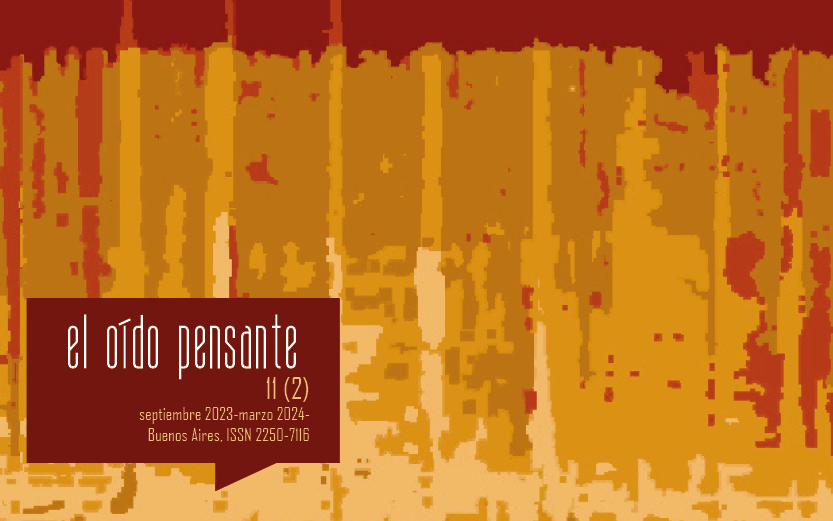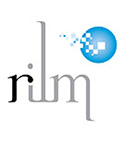Listening and Interpretation: A Peircean Semiotic Model for the Analysis of Listening
Abstract
In this article I propose an analysis of listening modes anchored in the semiotics of Charles S. Peirce and I evaluate the commensurability of this model with two recent approaches to the same problem (Santaella, 2017; Tuuri and Eerola, 2012). The operational model of the semiotic nonagon (Guerri et al., 2016; Guerri, 2020) allows me to describe nine modes of listening and explain their logical relationships in the form of a diagram. The model is adopted here from a personal approach, in which I propose to incorporate Peirce's late developments on his notion of the interpretant and the universes of existence (Jappy, 2017). The diagrammatic character of the semiotic nonagon emphasizes the processual aspect of semiosis, avoiding the static character of taxonomic proposals. The resulting listening model has been used for the analysis of artistic productions in university teaching contexts (Llobet Vallejos et al., 2021) and for the development of curatorial proposals that are based on the artistic appropriation of archive materials (Álvarez et al., 2021). At the same time, my personal approach to the semiotic nonagon suggests new theoretical lines of research on the applications of this methodology and on its bases on Peircean semiotics.Downloads
References
Alvarez, L. A., Llobet Vallejos, J. P., y Martínez Reparaz, U. (2021). La escucha de los archivos: La interfaz sonora como dimensión inesperada en la curaduría digital. II Simposio Internacional de Arte Sonoro (pp. 250-262). UNTREF. Recuperado de https://artesonoro.untref.edu.ar/es/simposio-edicion-2021
Bellucci, F. (2019). Peirce on Assertion and Other Speech Acts. Semiotica, 2019(228), 29-54. Doi: https://doi.org/10.1515/sem-2018-0081
Bellucci, F. (2021). Peirce on Symbols. Archiv Für Geschichte Der Philosophie, 103(1), 169-188. Doi: https://doi.org/10.1515/agph-2017-0087
Bergman, M. y Paavola, S. (Eds.). (s.f.). Interpretant. En The Commens Dictionary: Peirce's Terms in His Own Words. Recuperado de http://www.commens.org/dictionary/term/interpretant
Bonnin, J. E., Dvoskin, G., Lauria, D., López García, M., Salerno, P., Tosi, C. y Zunino, G. M. (14 de junio de 2022). ¿Qué dice la lingüística sobre el lenguaje inclusivo? UBAfilo. Recuperado de http://novedades.filo.uba.ar/novedades/%C2%BFqu%C3%A9-dice-la-ling%C3%BC%C3%ADstica-sobre-el-lenguaje-inclusivo
Gibson, J. J. (1979). The Ecological Approach to Visual Perception. Houghton: Mifflin and Company.
Guerri, C., Acebal, M., Alisio, J., Betancourt Ruiz, M. X., Binnevies, A. M., Bohorquez Nates, M., Pertot, W., Sastre, R. y Voto, C. (2016). Nonágono semiótico: un modelo operativo para la investigación cualitativa. Buenos Aires: Eudeba.
Guerri, C. (2020). The Semiotic Nonagon: Peirce’s Categories as Design-Thinking. En T. Jappy (Ed.). The Bloomsbury Companion to Contemporary Peircean Semiotics (pp. 277–302). Londres: Bloomsbury Academic.
Hartshorne, C., Weiss, P. y Burks, A. W. (Eds.). (1965). Collected Papers of Charles Sanders Peirce. Cambridge: Harvard University Press.
Jappy, T. (2017). Peirce’s Twenty-Eight Classes of Signs and the Philosophy of Representation. Londres: Bloomsbury Academic.
Kane, B. (2014). Sound unseen: Acousmatic sound in theory and practice. Oxford: Oxford University Press.
Llobet Vallejos, J. P., Figueroa, L., Lucangioli, J., Martínez, U., Nacif, M., Pola Cappellari, F., Prebisch, A. y Valverde, M. (2021). Comunicar la escucha: una experiencia de investigación artística en música en educación superior. En G. A. Alonso (Ed.). II Congreso Nacional e Internacional de Educación Artística 2019 (pp. 414-427). Rosario: Editorial de la Universidad Nacional de Rosario. Recuperado de https://educacionartisticacongreso.blogspot.com
Llobet Vallejos, J. P. y Stocco, P. (2020). Reorientando la música: un abordaje peirceano de la performance musical. En M. T. Dalmasso y C. Guerri (Eds.). Actas 14° Congreso Mundial de Semiótica. Trayectorias: Tomo 1. Trayectorias y teorías (pp. 243-257). Buenos Aires: IASS Publications y Libros de Crítica. Doi: https://doi.org/10.24308/IASS-2019-1-020
Nöth, W. (2013). Charles S. Peirce’s Theory of Information: A Theory of the Growth of Symbols and of Knowledge. Cybernetics & Human Knowing, 19 (1-2), 137-161.
Santaella, L. (2017). Nine Modes of Listening to Music. Recherches sémiotiques / Semiotic Inquiry, 37(1-2), 51-60. Doi: https://doi.org/10.7202/1051474ar
Short, T. (2007). Peirce’s Theory of Signs. Cambridge: Cambridge University Press. Doi: https://doi.org/10.1017/CBO9780511498350
Tuuri, K. y Eerola, T. (2012). Formulating a Revised Taxonomy for Modes of Listening. Journal of New Music Research, 41(2), 137-152. Doi: http://dx.doi.org/10.1080/09298215.2011.614951
Varela, F. J., Rosch, E. y Thompson, E. (1991). The Embodied Mind. Cognitive Science and Human Experience. Cambridge: MIT Press.
Wilder, B. (Dir.). (1960). The Apartment [Película]. The Mirisch Company.























